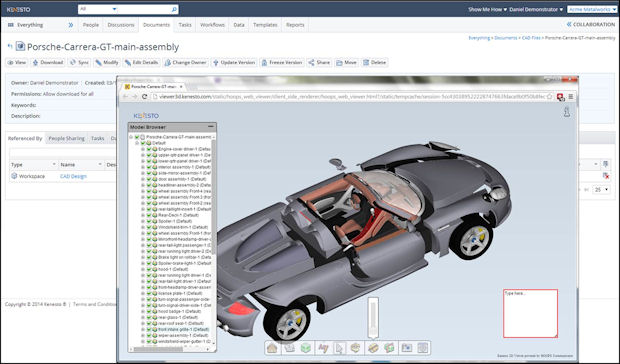Editor’s Pick: Document Management, Sharing and PDM Merge in the Cloud

Kenesto provides users the ability to view over 250 CAD, Microsoft Office and other document formats, which can improve project throughput and collaboration. Image courtesy of Kenesto Corp.
Latest News
November 12, 2014
 Dear Desktop Engineering Reader:
Dear Desktop Engineering Reader:
 Kenesto recently announced new vaulting and desktop file synchronization capabilities for its namesake cloud-based collaborative engineering data management solution. Kenesto is an interesting company and solution. More on those new capabilities in a bit.
Kenesto recently announced new vaulting and desktop file synchronization capabilities for its namesake cloud-based collaborative engineering data management solution. Kenesto is an interesting company and solution. More on those new capabilities in a bit.
Kenesto tags itself as being for mainstream engineering, design and lifecycle collaboration. By “mainstream,” it’s implying small- and mid-sized engineering outfits that do not have the budget, wherewithal or maybe the desire to support a pricey and labor-intensive PDM (product data management) or PLM (product lifecycle management) system. Yet, these companies still have the need for many or all of the features and functions of a PDM or PLM system that does not impede their agility and profitability. This is where Kenesto comes in.
Only the company does not like being boxed into those tags at all. With good reason.
Kenesto is really an engineering infrastructure provider. Its solution is not traditional like PDM or PLM at all. But it has the traditional functionalities you’d expect from one of those systems such as file sharing, the ability to view more than 250 CAD and document types, revisions, CAD file and document data management and change management. Kenesto strives to be more personal for both users and for the design and engineering firms that engage it by bringing modern computing and collaborative concepts to engineering business processes at an affordable monthly subscription rate.
Kenesto – we’re talking about the software now – started out as a workflow management and project execution system and still offers those functions. Still, it’s not just a boss’ thing to map out process and project flows, issue assignments or bossy e-mails and oversee progress toward gates and milestones. It lets individual users map out their own workflows. Managers can set up pre-defined or ad-hoc workflows with people inside or outside your company as the workflow demands. All of a program’s tasks and workflow processes, including sub-workflows and dependencies, can be captured, managed and tracked.
Kenesto reflects a personal cloud paradigm throughout its features. Its user interface offers a customizable dashboard that provides you with ready access to documents and information. You can drag and drop documents from your desktop directly to Kenesto. You can edit Microsoft Word, PowerPoint or Excel documents in the cloud. You can build custom forms and pages that capture, organize and distribute information. You can also create custom reports.
And on it goes. Tools are available for managing bids and engineering changes. You can have external supply or design chain partners in the loop without hassling them with another system from another company. You can even link to documents in your Dropbox account and enter them into tasks, workflows and so forth.
Kenesto’s new vaulting feature merges the document check-in and check-out functionality with the ability to synchronize documents between your desktop device and Kenesto. Kenesto can connect with shared network drives and remote vault folders that many outfits use to handle files. This can give you better security without the excessive cost and maintenance weights of a large system.
The file synchronization feature is neat because, well, you’re synching files from your desktop to the cloud. This functionality supports shared documents across a team as well as stakeholders inside and outside of a company. It obeys document security per your settings, provides automated file version management and supports update locking of files that have been finalized. It automatically notifies participants of updated documents, and Kenesto maintains a complete audit trail of who made changes and when they did it.
What this all means for you is that Kenesto joins the document management and document sharing paradigms of popular cloud tools with the key features of PDM. This, in turn, ensures you can manage and communicate documents properly. And keep in mind that you can use Microsoft Office applications to edit documents in the cloud as well. These features and some of the others previously mentioned are something different in the cloud and elsewhere. They’re also a good explanation why Kenesto resists being categorized as just another PDM/PLM outfit.
Kenesto is the brainchild of Michael Payne, who co-founded a number of technology companies, including PTC, SolidWorks and SpaceClaim. Payne, as you can see from that vita, has always been ahead of the curve. Kenesto seems to be really striving to bring together the ability to share, organize, manage and collaborate with our modern expectations of how computing for engineering business and data communication processes should operate.
You’ll find a whole lot more on Kenesto and its new vaulting and desktop file synchronization capabilities in today’s Pick of the Week write-up. You’ll also find links to the complete Kenesto feature set, pricing options and system requirements. The latter really just means certified browsers since Kenesto is a cloud-based solution, so all you need is a workstation and a connection. It’s highly recommended that you hit the link and take Kenesto for a complimentary ride to see what it’s all about.
Thanks, Pal. — Lockwood
Anthony J. Lockwood
Editor at Large, Desktop Engineering
Read today’s pick of the week write-up.
This is sponsored content. Click here to see how it works.
Subscribe to our FREE magazine, FREE email newsletters or both!
Latest News
About the Author
Anthony J. Lockwood is Digital Engineering’s founding editor. He is now retired. Contact him via [email protected].
Follow DE





